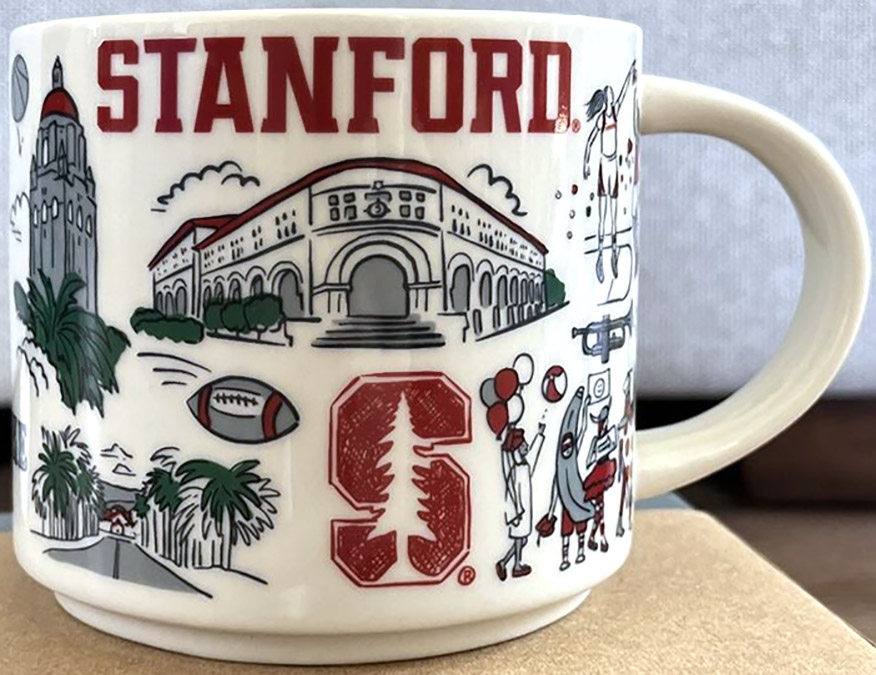
Been There – Stanford
Been There – Stanford is a mug for the university nestled in the heart of Silicon Valley which stands as a beacon of academic excellence and innovation. Established in 1885 by Leland and Jane Stanford in memory of their son, Leland Stanford Jr., it aimed to create a center of learning that would benefit humanity. The campus, designed by landscape architect Frederick Law Olmsted, opened its doors in 1891. Over the years, Stanford has played a pivotal role in advancing knowledge and research, particularly in areas such as technology, entrepreneurship, and the sciences. The university has weathered challenges, including the 1906 earthquake that devastated much of the campus, emerging stronger each time. Today, Stanford University stands as a world-class institution, blending a commitment to academic excellence with a spirit of innovation that continues to shape the future.
The front of the mug showcases the Stanford Cardinal logo, which is a simple yet powerful representation of the university’s athletic teams. The logo features a bold, stylized letter “S” in red, with a white outline. The color red signifies passion, energy, and determination, characteristics that are synonymous with Stanford’s athletes.
Speaking of the athletic teams that represent Stanford University – they are called the Stanford Cardinal and have an impressive track record of success. With a total of 134 NCAA team championships, Stanford holds the record for the most titles won by any university. Remarkably, the university has secured at least one NCAA team championship each academic year for an incredible streak of 47 years, starting in 1976-77 and continuing now. Additionally, Stanford athletes have excelled individually, earning a remarkable 544 individual NCAA titles. Stanford-affiliated athletes have also made their mark on the international stage, winning a staggering 296 Summer Olympic medals, including 26 at the 2020 Tokyo games.
In 1891, the inaugural assembly of Stanford University’s first students made the decision to designate cardinal red as the official color of the institution. Subsequently, in the 1940s, white was adopted as a secondary color.
Stanford University does not have an official mascot; however, the Stanford Tree, a representative of the Stanford Band donning a self-designed tree costume, makes lively appearances at significant Stanford sports events. Inspired by El Palo Alto, a redwood tree located in nearby Palo Alto, which is featured in the Stanford seal and athletics logo, the whimsical Stanford Tree adds a unique and spirited touch to the university’s presence in the sports arena. Students vie for the coveted position of the Tree during “Tree Week,” engaging in outrageous stunts to showcase their creativity and dedication. The selection process, overseen by the marching band, often involves bribes and unique performances. The chosen Tree, responsible for the costume design, brings a sense of humor and entertainment to football and basketball seasons, contributing to Stanford’s distinctive campus culture.
Hoover Tower, a notable landmark of the university, was completed in 1941 and is named after Herbert Hoover, the university’s distinguished alumnus and the 31st President of the United States. Standing at 285 feet tall, the tower houses the Hoover Institution Library and Archives, containing a vast collection of historical materials. With a unique blend of Romanesque and Byzantine architecture, the tower also features an observation deck offering stunning views of the Stanford campus and the Bay Area, symbolizing the university’s dedication to academic excellence and research.
White Memorial Fountain, located in front of the Hoover Tower, is a significant focal point known for its elegant design and tranquil surroundings. Also referred to as the “White Plaza Fountain,” it was dedicated in 1964 to honor the memory of Stanford alumna and trustee, Elizabeth Kenny Browning White. The fountain’s modernist style, featuring a circular basin with a central sculpture, complements the architectural aesthetics of its surroundings. Serving as a gathering spot for students and visitors alike, the White Memorial Fountain stands as a testament to the university’s commitment to fostering a sense of community and remembrance in the midst of its academic environment.
Throughout the year, students engage in fountain hopping, a tradition where they explore Stanford’s main campus, dipping their feet or swimming in various fountains among the university’s collection of 25 water features.
Stanford University is commonly referred to as “The Farm” due to its historical connection to Leland Stanford’s former Palo Alto Stock Farm. Leland Stanford purchased a large estate in the Palo Alto area in the late 19th century, which he initially used as a stock farm for his horse-breeding operations. The university itself was later established on this exact portion of this land. Over time, as the university grew and developed, the nickname “The Farm” stuck, serving as a reminder of its agricultural origins and contributing to the unique and affectionate terminology used by the Stanford community.
The Big Game stands as the enduring football rivalry between Stanford and UC Berkeley, dating back to its inception in 1892. Originally contested by the universities’ rugby teams, it has evolved into one of the oldest college rivalries in the United States. The coveted Stanford Axe, a trophy awarded to the victorious team, has a storied history. Originating in 1899 when Stanford yell leader Billy Erb brandished a lumberman’s axe for motivation, the Axe was later stolen by Berkeley students in 1899. In 1930, Stanford orchestrated an elaborate heist to reclaim the Axe, and in 1933, the schools agreed to exchange it as the prize for winning the Big Game. Notably, a restaurant at Stanford named “The Axe and Palm” pays homage to this historic trophy as of 2021.






















































































